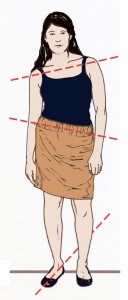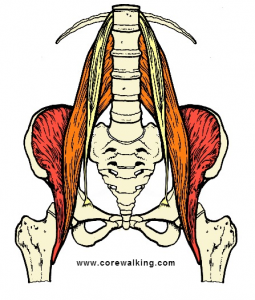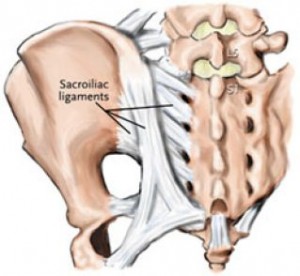All too many people have a tight psoas muscle if not two tight psoas muscles.
The expression of a tight psoas starts with a basic pattern and can go in many directions if left uncared for.
Unfortunately any tightening of either psoas muscle is going to affect the alignment and freedom of the sacroiliac joints.
The psoas major attaches to the base of the rib cage (T12) and the lumbar spine (L1-40) before moving forward and down to the cross the rim of the pelvis.
It then moves backward to connect to the back half of the inner thighbone, or femur.
The sacroiliac joints are between the sacrum and the ilium (part of the hip bone) connecting the pelvis together at the back of the body.
Nothing in the body works in isolation so any time the psoas becomes misaligned it will affect the sacroiliac joints.
 The initial manifestation of a tight psoas usually presents itself in the following way— the tight psoas shortens pulling the femur bone up into the hip socket and pulls the leg, and often the hip, forward rotating it externally.
The initial manifestation of a tight psoas usually presents itself in the following way— the tight psoas shortens pulling the femur bone up into the hip socket and pulls the leg, and often the hip, forward rotating it externally.
This also tends to turn the foot out slightly even elevating the arch of that foot.
At the same time the upper portion of a tight psoas both pulls the hip socket up and the shoulder down.
That is the patterns we see in the picture to the left.
This primary pattern can morph in different ways depending on how the spine reacts to the torque that arises from a tight psoas and can ultimately affect the opposite shoulder and the ribcage.
When both psoas are tight there are a host of other configurations to be found.
But dealing simply with this first pattern that I mentioned, the external rotation of the leg and the hiking of the hip have to mess with the sacroiliac joints.
The leg comes forward and turns out, rotating the ball of the femur head from the natural place in its socket.
That external rotation translates to the hip as well impinging the sacroiliac joint on that side.
Sacroiliac pain is often a result of a tight psoas even though the pain is referred and not felt in the psoas itself.
Everyone is tighter on one side of the body than the other so everyone has a psoas that is tighter as well.
If you look in a mirror it is likely that one shoulder is higher or lower than the other.
This is one of the first landmarks I look for in a new client. I check the level of the shoulders and then the level and torque of the hips.
But just because one psoas is tighter than the other doesn’t necessarily mean that the sacroiliac joint in impinged.
There is a degree of a tight psoas that we can all get away with but if the sacroiliac is suffering it is likely that a tight psoas is involved in the pain and its ultimate relief.


